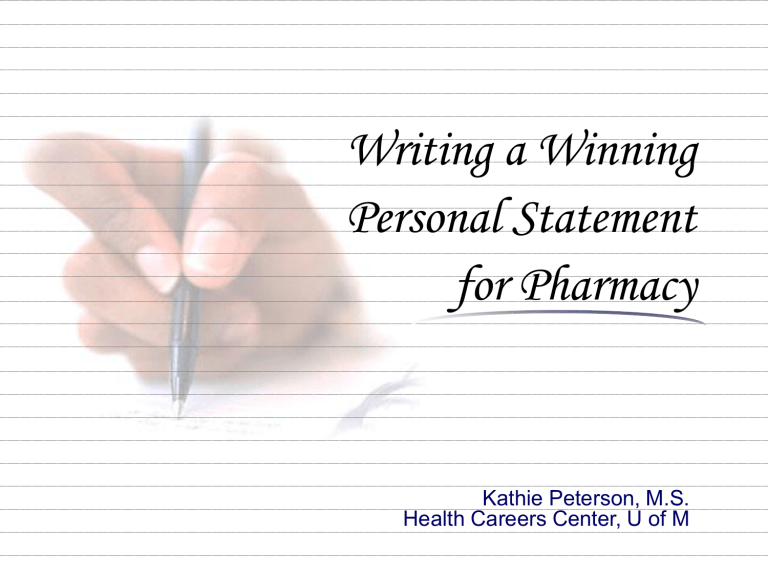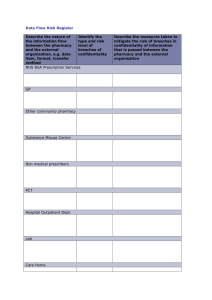Writing a Winning Personal Statement

Writing a Winning
Personal Statement for Pharmacy
Kathie Peterson, M.S.
Health Careers Center, U of M
What is the Personal Statement?
• Tells your story
• Presents your goals
• Reflects your aptitude, maturity, focus, and compatibility with pharmacy
• Provides evidence of your writing skills
• A critical factor in the admissions process
Why Pharmacy?
The personal statement is an opportunity to present you . Your statement should address three questions:
1) Why have you chosen pharmacy?
2) How do you know this is the right program/choice?
3) What do you have to offer the profession?
First Step: Research
• Self assessment
– Interests, personality, values, aptitude
• Trends in the discipline
– Readiness for the challenges of a career in pharmacy
• What’s needed to be successful in pharmacy?
– Fit with your life/career planning
Preparing to Write –
Personal Assessment
• How would I describe myself?
• How would others describe me?
• How did I become interested in this field?
• What are my professional objectives?
• What are my life goals and dreams?
Preparing to Write –
Academic Assessment
• How have my applied learning experiences
(e.g., work, volunteering, internship) contributed to my professional objectives?
• How do my research and clinical experiences relate to my goals?
• How do my academic choices reflect my interests and prepare me for a career in pharmacy?
• Ask: How does this make me unique?
What makes this significant?
Preparing to Write –
Special Considerations
• Special circumstances
Examples: low grades, switching major, gaps in enrollment, non-traditional status
• Reframe to focus on strengths and resilience
• Circumstance should be peripheral to the story
Framing the Statement
• Strategy #1:
– Background
– Academic Experiences
– Plans for Professional Study
• Strategy #2:
– Special emphasis
– Why is this a good fit for you?
• Strategy #3
– Weaving a story
– Themes
Structuring the Statement
• Can include:
– Relevant experience (academic, work-related)
– Awards and honors
– Membership in academic or related organizations
– Writing or publishing experience
– Internships or work experience that contribute to your professional maturity
• But NOT a restatement of your resume
• Your personal statement provides a framework for the supplemental application essay questions
Guidelines for Writing
• Start early
• Follow directions carefully
• Be yourself
• Be specific rather than vague – do not resort to cliches
• Passion is a given – show, don’t tell
• Be coherent and concise
• Be positive, realistic, and professional
Guidelines for Writing
• Personal tone – link personal information to professional interests and goals
• Vary your sentence structure and use transitions
• Do not hide behind highly structured language
• Assume admissions committee frame of reference
• Revise, revise, revise
Examples
Before:
“I am a compilation of many years gained from overcoming the relentless struggles of life.”
After:
“I was six years old, the eldest of six children in the Bronx, when my father was murdered.”
Examples
Before :
“My recognition of the fact that we had finally completed the research project was a deeply satisfying moment that will forever linger in my memory.”
After:
“Completing the research project at last gave me an enduring sense of fulfillment.”
Examples
Before:
“If it were not for a strong support system which instilled into me strong family values and morals, I would not be where I am today.”
After:
“Although my grandmother and I didn’t have a car or running water, we still lived far more comfortably than did the other families I knew. I learned an important lesson: My grandmother made the most of what little she had, and she was known and respected for her generosity. Even at that age, I recognized the value she placed on maximizing her resources and helping those around her.”
Final hints
• Consider consulting a style handbook
• Ask others to review your statement
– Examples: Faculty advisers, admitted students
– Use the “3 reader rule:”
• People who know you well and will be honest
• Someone who knows you a little bit (then have a conversation)
• The very best writer/editor you know





